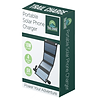
Solar power for camping
How Can Solar Power Improve Your Camping or Hiking Adventure?
what are the benefits of a solar camping generator as opposed to a petrol generator?
Solar generators have many benefits over a petrol generator, the main ones being silent operation and their environmental impact. Solar generators can also work at night or when there is little sun with the use of a battery.
In many areas where you might go camping, especially in dedicated campgrounds, there will be noise requirements preventing you from running noisy petrol generators. This can easily be avoided with a solar generator because they operate completely silently.
The only benefit that petrol generators have over solar equivalents is their power output per dollar spent. A solar generator which can output the same amount as your average 2KW petrol generator will likely cost up to $2,000 compared to a petrol generator costing around half that. However, because solar generators can be made for any power output (not just high power outputs like petrol generators) it is easy to make a camping sized generator for only a few hundred dollars. Which is cheaper than petrol generators!


Looking for a simpler solution than a full solar generator?
Our TrailCharge solar phone chargers are a great start! From just $49.90 they're a great way to keep your devices topped up for emergencies!
Check them out at The Solar Shop!
What does a solar camping generator cost?
That is an excellent question. You will see a price range which varies wildly all over the internet, some places saying it could be a as low as a few hundred dollars and others offering solar for up to $2,000
A great rule of thumb to use for smaller generators is that it costs about $10-$25 for each watt you want to generate. For example, a 40 watt solar generator should cost around $800-$900. This can vary though, depending on what size battery you want and whether or not you need an inverter.
To elaborate further, imagine you are camping for a few days and want to be able to charge devices and power a small mini fridge. In this case you will likely not need an inverter, and a smaller battery will do just fine. A rough idea of price may be between $1,000 to $1,500 You may decide that you want more power, or a bigger battery in which case we would love to design a system for you, just chat with one of our engineers!
If you want to power some larger devices, you may need an This is a device which transforms the DC power generated by your solar panels into AC power for your larger devices. An can increase the overall cost of your system by a reasonable amount, especially if you desire a large inverter for powerful devices.
what size camping generator will I need?
Great question! We get this one a lot so we've made a brief explanation below.
The key to this is to think about all the devices an appliances that you want to have powered while camping. Some common examples are:
Phone charges, LED Lights, Mini Fridges, Small Kettles, and Radios.
A phone will generally use around 10 watts while it is charging and assuming you change it once per day, it will use around 25Wh per day. From earlier we know that a 5 watt solar panel generates up to 25 WH per day on average, meaning that for each phone you want to charge you'll need 5 watts worth of solar panels.
Mini fridges tend to use a lot more power than a phone charger, in fact a regular sized mini fridge could use up to 80 watts while running. The good news is that mini fridges only use about 20% of their max power on average over a long period of time. Therefore the average mini fridge only uses roughly 380Wh per day. From this we can estimate that for an average mini fridge you need about 60-70 watts of solar power.
Radios and LED lights are on the opposite end of the spectrum and can often even be powered from a USB socket.
To calculate an all up size for your solar generator, look at the power rating on the back of all your devices and see how much power it uses. Then multiply that by how long you want it on for each day and divide the result by 5.
This is the number of watts of solar power you need.
What is an inverter? How do I know if I need an inverter?
Lots of people have questions about what an inverter is, thankfully we are here to help!
Dynamic Solar Systems takes all the hassle out of designing a solar system perfect for your conditions, Including working out weather or not you need an inverter and even what size inverter you may need!
An inverter is a device used to convert the DC power which is generated by solar panels and stored in batteries into regular AC power which you find in normal power outlets in you house. An inverter is very useful when you need to power larger devices which do not work with standard 12VDC Power such as laptop chargers, and TV's.
There are two types of inverter, a modified sine wave and a pure sine wave. The modified sine wave is the cheaper one which generates "dirty" power. It is only really good for appliances which are not sensitive like lighting. Pure sine wave inverters on the other hand generate a much cleaner output, this is good for all other devices, even sensitive medical equipment. As you have probably guessed, modified sine wave inverters are generally cheaper however we usually don't recommend them due to them bein gold fashioned and in-efficient.
If you do not plan on using your generator for high power devices, there is rarely a need for an inverter as it just costs extra money.

